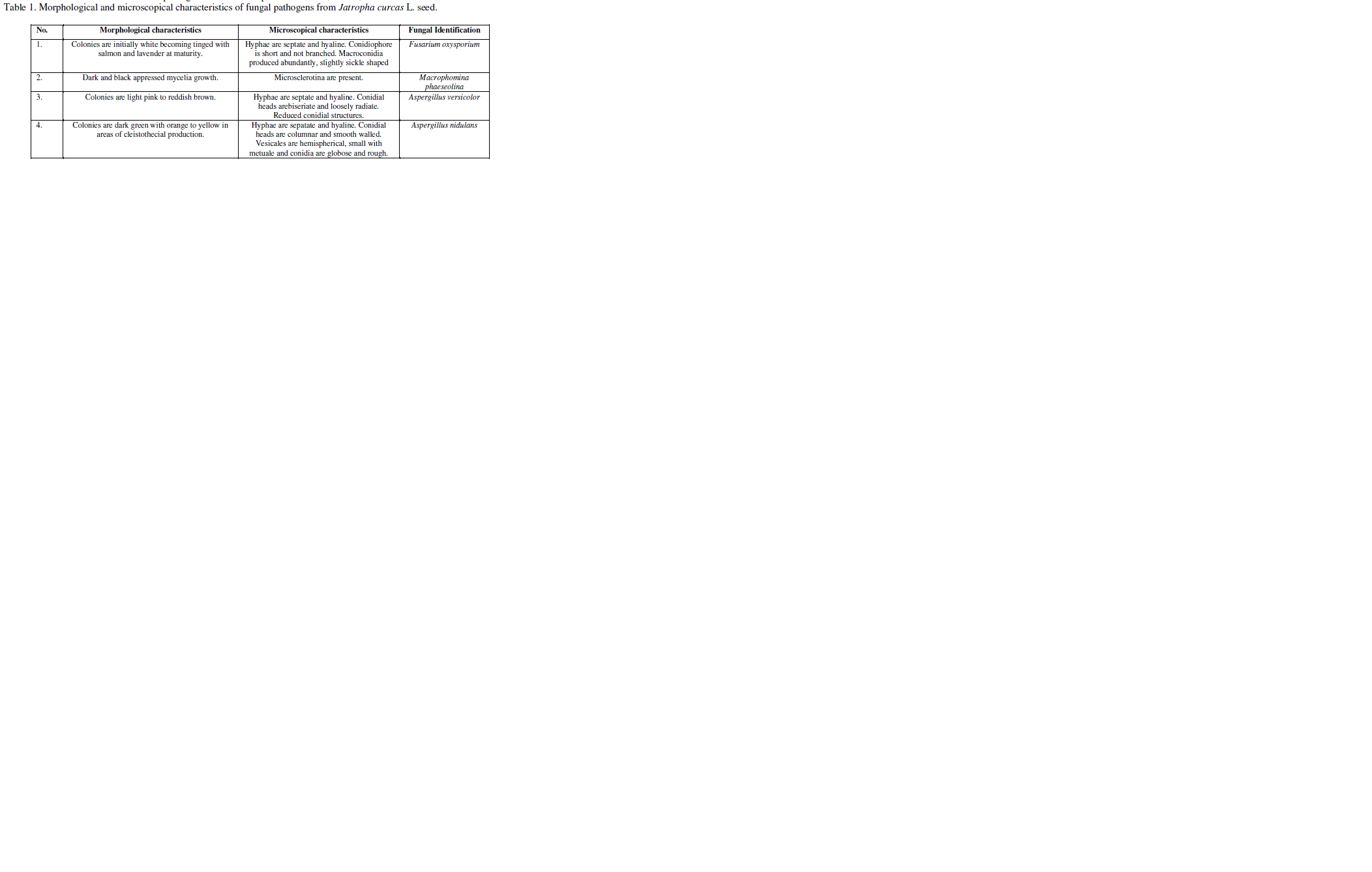ISSN ONLINE(2319-8753)PRINT(2347-6710)
ISSN ONLINE(2319-8753)PRINT(2347-6710)
|
Meenu Saraf, Urja Pandya, Aarti Thakkar, Palak Patel Department of Microbiology and Biotechnology, University School of Sciences, Gujarat University, Ahmedabad 380009, Gujarat, India |
| Related article at Pubmed, Scholar Google |
Visit for more related articles at International Journal of Innovative Research in Science, Engineering and Technology
Seeds attacked by soil borne fungal pathogens are responsible for decrease in germination rate, plant growth and result in losses in yield. The present study aimed to identify fungi associated with Jatropha curcas seeds and biocontrol of these pathogens by PGPR strains with their indirect mechanisms. Four fungal species namely Fusarium oxysporum, Macrophomina phaseolina, Aspergillus versicolor and Aspergillus nidulance were isolated from Jatropha seeds. Ten strains of PGPR isolated from rhizosphere of agricultural crops were studied for their antagonistic activity against seed borne fungal pathogens of Jatropha curcas L. After 5 days of incubation, both MSC1 (Pseudomonas putida) and MSC4 (Pseudomonas pseudoalcaligens) inhibited the growth of M. phaseolina by 90 and 45% respectively. Both the strains showed maximum lytic enzymes production under normal growth conditions. Results revealed that MSC1 and MSC4 treated Jatropha curcas offered 29% and 32% disease reductions of M. phaseolina respectively over the infected control.
Keywords |
| Antagonism, Biocontrol, Enzymes, Phytopathogens, Pseudomonas |
INTRODUCTION |
| Seed borne mycoflora have been found to affect the growth and productivity of crop plants. A seed borne pathogen present externally or internally or associated with the seed as contaminant may cause abortion, seed rot, seed necrosis, reduction or elimination of germination capacity as well as seedling damage. This results in development of diseases at later stages of plant growth by systemic or local infection [1]. The oil plant Jatropha curcas L., a multipurpose drought resistance, perennial plant belonging to Euphorbiaceae family is gaining a lot of importance for the production of bio-diesel [2]. The seeds of physic nut are a good source of oil which can be used for blending with diesel substitute. Infected Jatropha seeds imply an irreversible degenerative change in the quality of seed after it has reached its maximum quality level. The fungi associated with seeds at the harvest stage and under storage bring about several undesirable changes and degradation of seed constituents, thus making the seed unfit for oil extraction, export purpose, consumption or sowing [3,4]. Black rot in Jatropha curcas L. plantations by B. dothidea, F. oxysprum, M. phaseolina, P.longicolla and A. alternata that caused black lesions (soft and rotting) on the stem under the bark and cambium, then they spread to the stems causing shriveling and gummosis of hard wood stems and finally led to the death of the infected plant[5]. Rhizospheric soil is a repertoire of microorganisms that includes beneficial rhizobacteria and pathogenic species that thrive in a nutrient enriched environment. Beneficial rhizobacteria are known to antagonize root pathogens through competition for nutrients and niche, aggressive colonization, parasitism, predation, production of lytic enzymes, antibiotics, bacteriocins, salicylic acid, release of volatiles, surfactants, rhamnolipids and induced systemic resistance [6]. Recent environmentallyfriendly cultivation practices emphasize the need to maintain the microbial balance in the rhizosphere by application of plant growth promoting rhizobacteria (PGPR) and thereby, limit the density of soil borne pathogens to a minimum level for disease control [7]. Also, in disease control programs, the density of biocontrol agents in rhizosphere and efficient root colonization has a clear relationship with suppression of soil borne plant diseases. Among such beneficial rhizospheric microflora, species of Pseudomonas and Bacillus are well known for their plant growth promoting potential, aggressive rhizospheric colonization, and antagonistic abilities including the secretion of number of metabolites including antibiotics, volatile hydrogen cyanide (HCN), siderophores, lytic enzymes like chitinases and β 1, 3 glucanases. Pseudomonads have been reported for biological control of different fungal species such as Rhizoctonia, Fusarium, Sclerotium, Pythium and Macrophomina [8]. Thus, the present work was designed to study the biocontrol efficacy of PGPR (Plant growth promoting rhizobacteria) isolates against fungal pathogens that caused diseases in the seeds of Jatropha curcas. |
MATERIALS AND METHODS |
| Bacterial isolates |
| Ten bacterial isolates viz. MSC1, MSC4, B15, B7, B8, K8, K10, K11, K2 and K7 were obtained from the corresponding author’s collection section, Department of Microbiology and Biotechnology, Gujarat University, Gujarat, India. They were maintained on Nutrient agar media at 280C for 2 days. These isolates were already studied for their plant growth promoting potential like phosphate solubilization, siderophore production, IAA production [9]. Isolation of fungal pathogens Pathogenic fungi were isolated from the infected seeds of Jatropha curcas by single spore isolation and maintained on potato dextrose agar (PDA) medium. They were identified based on the colony morphology and lactophenol cotton blue strains techniques which determine the type of reproductive mycelium, conidiophore shape, attachment, color of spore [10]. In vitro antagonistic properties Antagonistic properties of PGPR isolates were tested against F. oxysprum, M. phaseolina, A. versicolor, and A. nidulance on plates having an equal proportion of NAM (Nutrient Agar Medium) and PDA (Potato Dextrose Agar) by dual culture technique [11]. Growth inhibition was calculated by measuring the distance between the edge of bacterial and fungal colonies, and percent inhibition was calculated by following formula: % Growth inhibition = [(C-T)/C] ×100 Where C = Radial growth of fungus in control, T = Radial growth of fungus in dual culture Cell wall degrading enzyme activities Chitinase activity was tested on a chitin agar plate containing 1.62 g nutrient broth (Difco, USA), 0.5 g NaCl, 6 g M 9 salts (Difco, USA), 8 g colloidal chitin and 15 g agar per liter; formation of clear halos surrounding growth after 3 day incubation at 300C indicated positive chitinase activity [12]. Proteolytic activity was determined by using skimmed milk agar (pancreatic digest of casein 5 g, yeast extract 2.5 g, glucose 1 g, 7% skim milk solution 100 ml, agar 15 g dissolved in 1 l distilled water). After 2 days incubation at 280C, a clear zone around the cells indicated positive proteolytic activity [13]. Cellulase activity was determined on M9 medium agar amended with 10 g of cellulose and 1.2 g of yeast extract per litre of distilled water was used, in which a clear halo after 3 days of incubation of the colonies at 280C was considered as positive for cellulase production [14]. Enzyme Assays Chitinase assay : Quantitative Assay for chitinase enzyme production was carried out in 50 ml of chitin medium [15]. Chitinolytic activity of culture was assayed by measuring release of reducing sugar from colloidal chitin by DNSA method. Amount of reducing sugar released from chitin was determined by reading absorbance at 530 nm. One unit of chitinase was defined as the amount of enzyme which produced 1 μ mole glucose equivalent per minute under the assay conditions. Protease assay: Quantitative protease activity was determined by using skimmed milk containing Nutrient broth [13]. 50 ml medium was incubated with activated bacterial culture and inoculated at 30+2 °C on shaker (150 rpm) for 3 days. Estimation of released tyrosine amino acid was measured by Lowry’s Folin Reagent Method. The blue color development was read in spectrophotometer at 700 nm. Cellulase assay :Cellulase activity was assayed by the determination of reducing sugar released from carboxymethyl cellulose (CMC). For that 0.5 ml of culture supernatant fluid was incubated with 0.5 ml 1% CMC in 0.05 M sodium acetate buffer, pH 4.8 at 400C for 1 h. The reducing sugar product was assayed by the dinitrosalicylic (DNSA) method [16] using glucose as the sugar standard. Controls for carbohydrate produced from substrate and of the enzyme preparation were included. One unit of cellulase was defined as the amount of enzyme which produced 1 μ mole glucose equivalent per minute under the assay conditions. Greenhouse experiments: Jatropha seeds (Jatropha curcas SDAU J1 Chhatrapati), collected from the Regional Research Station S.D. Agriculture University, Sardarkrushinagar, Gujarat, were soaked in 0.02 % sodium hypochlorite for 2 min and washed five times with sterilized distilled water. Seeds were coated with 1 % carboxymethylcellulose as an adhesive. Seed bacterization was done as described by Jha & Saraf [17]. Inoculum of M. phaseolina was prepared by method of Singh et al. [8] .The earthen pots (24cm x 12cm x 12cm) were filled with sterilized soil. Jatropha seeds were sown in six sets of treatment: (i) soil without bacteria and fungus (ii) M. phaseolina control (iii) Soil inoculated with MSC1 (iv) soil inoculated with MSC1 and M. phaseolina (v) Soil inoculated with MSC4 (vi) soil inoculated with MSC4 and M. phaseolina. Growth parameters were recorded after 30 days of inoculation and disease incidence was determined as percentage of the plants showing root rot symptoms. Three replications of each treatment were performed. |
RESULTS AND DISCUSSION |
| Isolation and Identification of bacterial and fungal strains: All ten PGPR isolates used were gram negative, short rods, non spore forming, non capsulated and motile rods. Colonies were smooth, translucent, large, low convex. Among all the isolates, MSC1 (Pseudomonas putida- accession number GU 553133) and MSC4 (Pseudomonas pseudoalcaligens- accession number GU 564407) were identified in the previous study as good plant growth promoting rhizobacteria [9]. Four fungal phytopathogens were isolated from Jatropha curcas seeds on PDA medium by single spore isolation. These four pathogens were identified on the basis of their morphological and microscopical characters (Table 1). Table 1. Morphological and microscopical characteristics of fungal pathogens from Jatropha curcas L. seed. |
 |
| In vitro antagonistic properties |
| Fungal growth inhibition |
| Biocontrol of pathogenic fungi was studied by using ten PGPR on liquid medium. Growth inhibition of all four fungal pathogens ranged from 20 to 90% in liquid medium after five days of incubation (Fig.1). MSC1 showed maximum 60%, 90% and 78% inhibition against F. oxysporum, M.phaseolina and A.versicolor respectively. Whereas, isolate MSC4 and B7 showed 75.6 % and 67.9% respectively against A. versicolor. MSC1 isolate also showed maximum inhibition (60%) followed by MSC4 (51.3%) and K7 (50%) respectively against A. nidulance. Enhanced plant growth in addition to disease control has been achieved with Pseudomonas and Bacillus [18, 19]. Pseudomonas spp. is reported for the biocontrol of different fungi including species of Rhizoctonia, Fusarium, Sclerotium, Pythium, Erwinia and Macrophomina [20]. |
 |
| Enzyme Assays |
| Only five isolates formed clear zones around the spot on chitin agar plates, which confirm the chitinase activity. Further, these strains were assayed for their chitinase activity in liquid medium (Fig. 2). Chitinase activity was measured by measuring the amount of releasing sugar after 14 days of incubation. On solid medium zone of diameter was ranged from 5 to 17mm after five days of incubation. Chitinase activity ranged from 0.2 to 0.17U/ml by all the isolates. Maximum activity was observed by isolate MSC4 (0.25U/ml) and MSC1 (0.17U/ml). Both the qualitative and quantitative cellulase production was studied (Fig. 3). Cellulase activity was measured by measuring the amount of releasing sugar after 14 days of incubation. On solid medium zone of diameter was ranged from 5 to 15mm after five days of incubation. Cellulase activity ranged from 0.05 to 0.25 U/ml by all the isolates. Maximum activity was observed by isolates MSC1 (0.25U/ml) and MSC4 (0.15U/ml). Protease activity was measured by measuring the amount of releasing sugar after 14 days of incubation (Fig. 4). On solid medium zone of diameter was ranged from 13 to 25mm after five days of incubation. Protease activity ranged from 95 to 200 U/ml by all the isolates. Maximum activity was observed by isolate MSC1 (200 U/ml). |
| Chaiharn et al. [21] reported screening of PGPR isolates on the basis of lytic enzymes production like chitinase (6%), protease (5%) and cellulase (6%) from total of 220 phosphate solubilizing bacteria that were isolated from different rhizosphere soil in Northern part of Thailand. Pseudomoands strain MIP3 produced maximum chitinase (340 μM/ml) and β 1, 3 glucanase (450 μM/ml) production which caused 87% inhibition of Aspergillus spp. reported by Saraf et al. [22]. In the present study, growth inhibition of all four fungal pathogens may be attributed to the cumulative effect of all extracellular antifungal compounds including siderophores, HCN, chitinase, cellulase and protease. Green house experiments: Results of the in vitro study showed that among all the ten isolates MSC1 and MSC4 showed maximum inhibition against all the four fungal phytopathogens especially against M. phaseolina by producing maximum amount of lytic enzymes. Therefore, these two isolates MSC1 and MSC4 were selected for biocontrol potential against M. phaseolina under greenhouse experiments. Maximum stimulatory effect on vegetative plant growth parameters (viz. shoot-root length and seedling biomass)was recorded with treatment of MSC1 alone followed by MSC1+ M. phaseolina (Table 2 and Fig. 5). Results revealed that Jatropha seed treated with MSC1 showed significantly higher root and shoot length (21.14 and 62.94%) whereas two fold and fourfold increase of fresh and dry biomass was observed in M. phaseolina infested soil. In M. phaseolina infested soil, plant showed rot symptoms when harvested after 30 days. Sclerotia were clearly visible beneath the epidermis of the root and collar region of infected plant and showed 85% of disease incidence. When treated with MSC1 and MSC4, disease incidence was only 29% and 32% respectively. Similar results were obtained with PGPR strains like Bacillus subtilis BN1 from the rhizospheres of chir pine (Pinus roxburghii; [23], fluorescent Pseudomonas GRC2 from potato rhizosphere [24], and Pseudomonas chlororaphis SRB 127 from sorghum rhizosphere [25] that showed strong antagonistic effect against M. phaseolina, a charcoal rot pathogen of peanut and sorghum. |
 |
| Valued are mean of three replicates. * Significant at 5% (P< 0.05 level of ANOVA), ** Significant at 1% (P< 0.01 level of ANOVA), ns Not significant at 0.05 level of LSD as compared with control. |
 |
 |
CONCLUSION |
| Our findings establish the possible application of antagonistic pseudomonads strains (MSC1 and MSC4) in bioprotection against the seed borne disease as well as growth promotion of Jatropha curcas. This study highlights the importance of lytic enzymes (chitinase, cellulase and protease) produced by MSC1 and MSC4 for biocontrol of pathogens. Further investigations have to be carried out to find out the important antifungal compounds that can influence the disease reduction by both the strains. |
References |
|